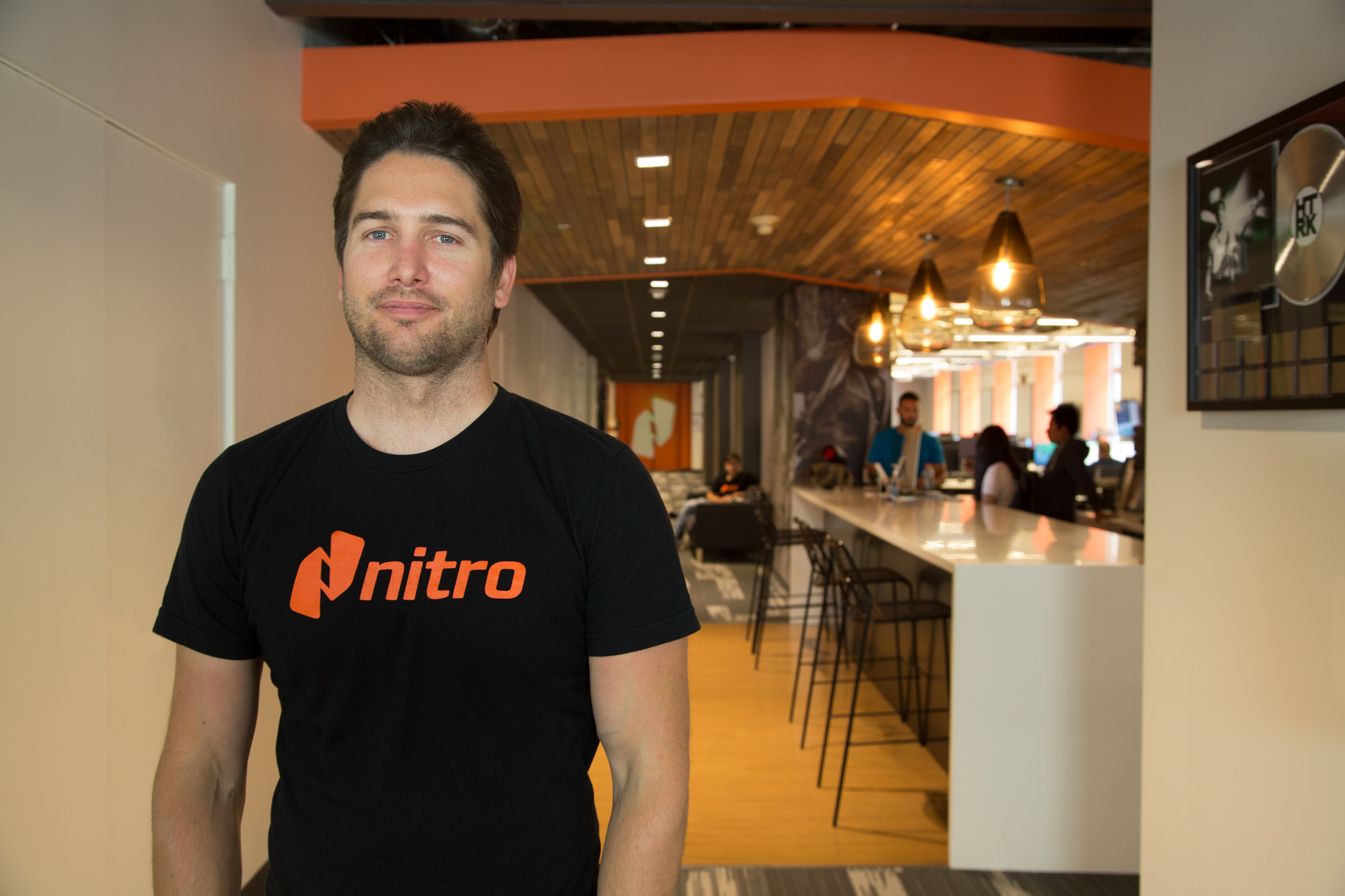Why start-ups are ditching Australia for sunny San Francisco

Nitro founder Sam Chandlers' solo mission to San Francisco is paying off handsomely. Source: Nitro
It has taken a decade but local technology entrepreneur Sam Chandler reckons his labour of love, Nitro, is finally ready to spread its wings and along the way knock Adobe Acrobat off its perch.
Australian born and bred, the document productivity firm recently announced a multi-million dollar funding round that paves the way for Nitro to turbocharge its quest for scale.
Nitro's latest success is built on the fact that the company has been profitable since inception and is on track to post $US30 million in revenue this year.
However, Chandler points to another reason behind Nitro's progress. The decision to take his company away from antipodean shores and into the belly of the beast – Silicon Valley.
But why? What does the US offer that Australian markets still cannot, and what drives so many of our home-grown tech talent to make the leap?
Founded in 2005, Nitro now has bases in both San Francisco and Melbourne, along with Ireland and Slovakia, and Chandler made a very conscious strategic play to move Nitro's headquarters to California as quickly as he could.
It wasn't an easy decision but one that has so far paid off.
"When we made the decision to move the headquarters to San Francisco it began with just me flying solo," says Chandler, who studied business at RMIT.
"I think we had 12 people in Melbourne when I moved across, so it was kind of a strange experience for both me and for the company. The company felt like it had just started to get growing and all of a sudden the CEO left to tackle San Francisco. We basically had to start again, but I'm really glad we did."
One of the most common reasons for early stage companies moving to San Francisco is the talent pool on offer, which Chandler says is on an entirely different scale to anything available in Australia.
While there is talent here, according to Chandler, it's still consigned into disparate clusters and still finding its feet.
“We decided to do it at the time because we couldn't find the kind of talent we needed in Melbourne, for the kinds of roles we were hiring for. We were hiring specialists in things like art and technology, and there just wasn't a rich pool of talent for those kinds of roles,” he says.
Things have improved a great deal in Australia since Nitro made its move but Chandler says that the reasons that propelled him towards San Francisco are still just as strong.
Money talks
Another motive is dollars and funding. As Chandler points out Nitro's latest $US15 million win simply wouldn't be possible in Australia. That level of money simply isn't available here.
"In the back of our minds we were thinking 'if we're ever going to raise money, of if we are ever going to IPO, the best place to do that is going to be the States'," Chandler says.
"The simple fact is that in San Francisco we could basically talk to 12 huge Venture Capital firms that specialise in enterprise software as a service.”
And that's just the shortlist - not the long list! As Chandler points out, the VC ecosystem in the US is so extensive that dozens of specialist VC firms can crawl out of the woodwork if you have the right stuff on offer.
“It doesn't matter if you're consumer, or if you're enterprise software. There's going to be firms that have that track record, and will bring a lot to the table in terms of expertise.
That kind of specialisation of expertise, according to Chandler, is just as valuable as the money.
CEO of mobile application design firm Alive Mobile Luke Harvey-Palmer agrees, telling Business Spectator money talks when weighing up staying in Australia or making the leap across the Atlantic.
"Funding's the big draw card," he says.
"A lot of business talk about A, B and C round funding as being a real problem in Australia, we know it's a real problem, and that's fundamentally what draws people to the US, the availability of serious cash.”
Australian investors are obsessed with revenue and EBITDA, which Harvey-Palmer says are very conservative multiples and highlight the timidity prevalent in our markets.
"For a lot of businesses with ambition, trying to access bigger markets on the supply and the demand side just makes sense. The thing driving people to the US is more favourable valuations, and seeking a better second and third round of investment.
Australia still playing catch-up
So is Australia forever destined to be an also-ran? Perhaps, but there's more to emulating the Silicon Valley model down under than access to capital and specialised VCs.
A more realistic outlook sees Australia settling into a role as a second-tier player, but only after a renewed focus on innovation from both government and key industry talent.
"I don't think anywhere in the world is going to be able to replicate Silicon Valley," Chandler says.
"It's the culture, it's openness to innovation, it's embracing of innovation and it's looking forwards to the future, it's that mindset that the Valley has that is pretty unique in the world. What you find here in Silicon Valley are a lot of optimists, optimists with the ability to access capital markets It's kind of frightening when you look around the world there's a lot of anti-technology bias in so many places, and that's holding those places back."
According to Chandler, replicating SIlicon Valley's culture and attitude towards innovation necessarily involves participation from everyone from universities, large tech companies, small tech companies, and the talent that moves between all of them.
"That's one of the problems with Australia; we don't have a big enough talent pool for it to be close to a Silicon Valley, yet. Ireland has a much richer talent pool than Australia does. But that's a country of four million people, I think. Compared to Australia's 24 million, or something like that. For a country that has 20 million less people than Ireland does, there are fewer appropriately skilled technology workers.
"Over the last two years the Irish government, very smartly, has chosen to bring technology companies into Ireland by making it very compelling for those companies to set up there. And now what you have is this pool of very talented Irish people who are currently working at Google or Salesforce or Microsoft or Facebook or you name it. All those companies are in Dublin and at scale, so when a company like Nitro wants to expand, we compare locations and the obvious place to recruit and to grow is Ireland.
The Australian government has been lauded for its recently-announced changes to the tax laws governing start-ups, which supersede what Chandler describes as "one of the worst pieces of legislation ever written" and will possibly encourage more investment globally in Australian start-ups.
The changes will mean workers will no longer have to pay tax when they receive stock options but only when they're sold, provided the shares are held for at least three years. To be eligible however, companies must have an aggregate turnover of less than $50 million, be unlisted and incorporated for less than 10 years. This means established firms like Nitro will soon miss out.
The rise and rise of Asia
The US and Ireland aren't the only places on the start-up radar. Harvey-Palmer says Asia is often over-looked for re-location because of the hard work involved and the cultural differences which are sometimes jarring.
"A lot of the reasons Australians are looking to the US rather than Asia for example - there's the perception it's a lot easier to sell to an American. Whether that's selling concepts for capital or selling to a customer for revenue, bottom line is it's perceived as a very easy market to sell in," Mr Harvey-Palmer says.
"There was some investment in a travel business in China about 18 months ago now, and it was equal to $100 million in the US, for about 20 per cent of the business. And that was a travel business that competes with Airbnb. Chinese and East Asians have no trouble investing that kind of money, whether it be through venture funds, angel or corporate venture capital. Whereas you'd struggle to find an investment bigger than about US$10 million in South-East Asia. They're very different.
The difference too in effort required seems steep and prohibitive on the surface. Why take six or 12 months to research a new market, with intimidating cultural and language barriers to deal with? Getting a start-up off the ground is hard enough as it is without the extra hurdles, right?
It's not for everyone, but East Asia may just be the perfect destination for start-ups willing to do the ground work required, and Australian businesses are uniquely positioned to take full advantage of the opportunities on offer.
"The sheer vastness of the markets is frightening, the numbers are amazing, people just need to be bold, purposeful and clear about what they want," Harvey Palmer adds.
"East Asia should be a market Australian business should be taking seriously, I think."













